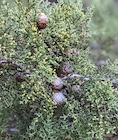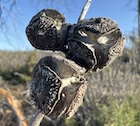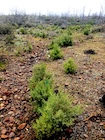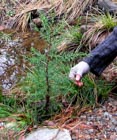
A grove, growing on ultramafic rock in The Cedars, a remote area of Sonoma County named for its groves of Sargent cypress [Jackie Sones, Apr-2015].

A mature tree on ultramafic rock in The Cedars [Jackie Sones, Apr-2015].

Mature trees in habitat on serpentine-derived soil, iNaturalist observation 189372367 [spyingnaturalist, 2023.10.29].

Foliage and maturing cones on a tree in habitat, iNaturalist observation 168657785 [James Bailey, 2023.06.19].

Foliage, mature cones, and ripe pollen cones on a tree in habitat, iNaturalist observation 192100559 [Peter McCluskey, 2023.11.25].

Cones opened in response to a burn, iNaturalist observation 151365943 [Susan Fawcett, 2023.03.16].

Sapling-sized regeneration in a recently burned stand, iNaturalist observation 161735994 [Marisol Villarreal, 2023.05.06].

A sapling in habitat in the Siskiyou Mountains of Oregon. The area had burned and no adult trees survived, but some regenerating seedlings were found [C. J. Earle, 2011.01.30].

Foliage on the seedling shown above [C. J. Earle, 2011.01.30].

Conservation Status

Hesperocyparis sargentii
(Jeps.) Bartel (2009)
Common names
Sargent cypress (Peattie 1950).
Taxonomic notes
Synonymy: see POWO (accessed 2023.12.16).
Description
"Trees to 25 m, but often shrubby and less than 10 m; crown broader than tall or columnar, dense or open. Bark rough, furrowed, fibrous. Branchlets decussate, (1.5)2-2.5 mm diam. Leaves usually with inconspicuous, shallow, pitlike, abaxial gland that usually does not produce drop of resin, often glaucous. Pollen cones mostly 3-4 × 2 mm; pollen sacs 3-4. Seed cones usually globose, mostly 2-2.5 cm, brown or gray, not glaucous; scales mostly 3-4 pairs, with scattered resin blisters, umbos inconspicuous or to 4 mm. Seeds 4-6 mm, dark brown, faintly to prominently glaucous" (Eckenwalder 1993).
Distribution and Ecology
USA: California: Coast Ranges from extreme N Mendocino County (Red Mtn.) and Cooks Springs, Colusa County; south through Lake, Napa and Marin Counties; reappearing on Cedar Mtn., Alameda Co.; in the Santa Lucia Mtns. of Monterey Co. and San Luis Obispo Co.; and on Zaca Pk. (at 915 m) in the San Rafael Mtns. of northern Santa Barbara Co. (Peattie 1950).
Data from USGS (1999).
Found at 200-1100 m in chaparral, foothill woodland, and lower montane forests, often on serpentine (Eckenwalder 1993). These sites have a Mediterreanean (maritime winter-wet) climate with about 600 mm annual precipitation (Peattie 1950). Hardy to Zone 8 (cold hardiness limit between -12.1°C and -6.7°C) (Bannister and Neuner 2001). See also Thompson et al. (1999).
Remarkable Specimens
American Forests (2000) record the largest trees as 44 m tall, dbh 120 cm, crown spread 12 m; in Sonoma County, California.
Ethnobotany
No data as of 2023.12.16.
Observations
Wolf (1948) provides the following information for the Cypress Mountain grove, which he feels is "the finest for the species": Cypress Mountain is a notable peak in the southern Santa Lucia Mountains, approx. 2900 feet in elevation. The cypress grove is on the NE side of the mountain near its summit, and mainly occupies ravines draining into Las Tablas Creek. The trees grow on serpentine rock outcrops and are mainly located in T.27S, R.9E, S.12. Some trees exceed 30 m height and 100 cm dbh. HERE is the summit of Cypress Mountain, courtesy of Google Maps.
Herbarium collections have also been made in the following locales: 1) Sonoma County: NE of Occidental on Stoetz Lane, off Harrison Grade; 2) Sonoma County: Duvoul Creek ridge S; E of Bohemian Highway (N of Camp Meeker). Peattie (1950) also suggests looking for it at the NE base of Mt. St. Helena (Lake/Napa County), on Mt. Tamalpais (Marin County), on Cedar Mtn. near the Lick Observatory in Alameda County, and the mountains just behind the Hearst Castle (San Luis Obispo County).
Remarks
The epithet honors Charles Sprague Sargent (1841-1927), first director of the Arnold Arboretum, where he remained until his death 54 years later.
Citations
American Forests 2000. The National Register of Big Trees 2000. Washington, DC: American Forests.
Bartel 2009: described in Adams, R. P., J. A. Bartel and R. A. Price. 2009. A new genus, Hesperocyparis, for the cypresses of the western hemisphere. Phytologia 91(1):160-185.
Farjon (2005) provides a detailed account, with illustrations.
Jepson, W. L. 1909. A Flora of California, Vol. I, p. 61. Available: Biodiversity Heritage Library (accessed 2023.12.17).
See also
The species account at Threatened Conifers of the World.
Bisbee, Jeff. 2006. Photos at the Cupressus Conservation Project website.
Griffin and Critchfield (1972).









